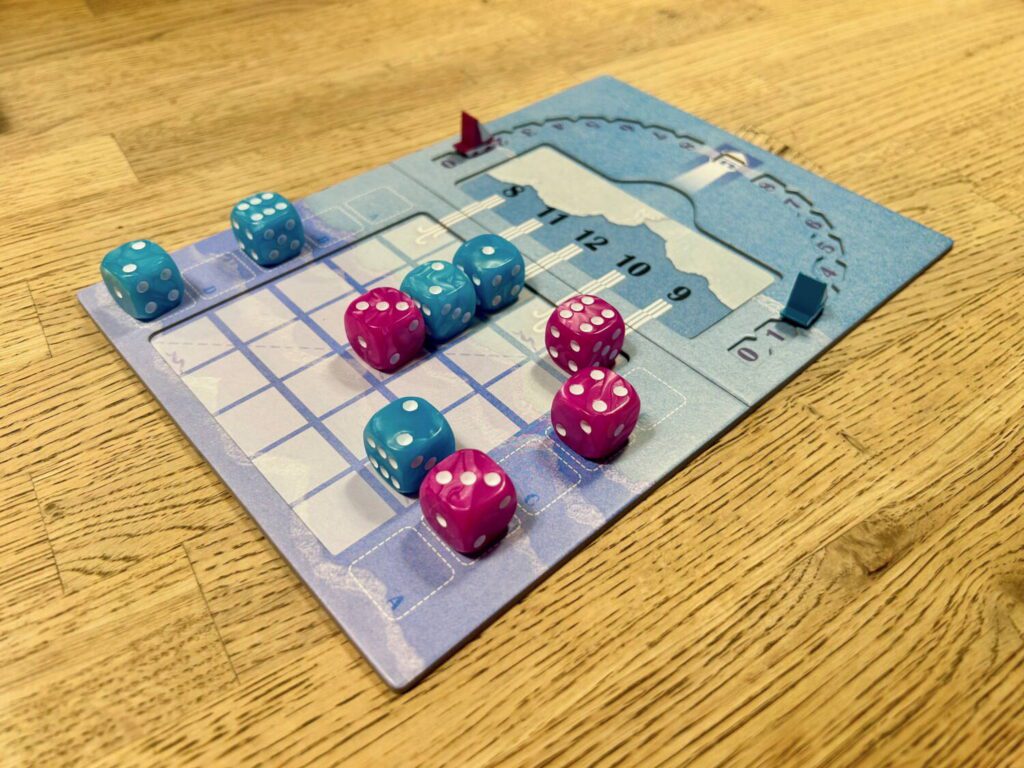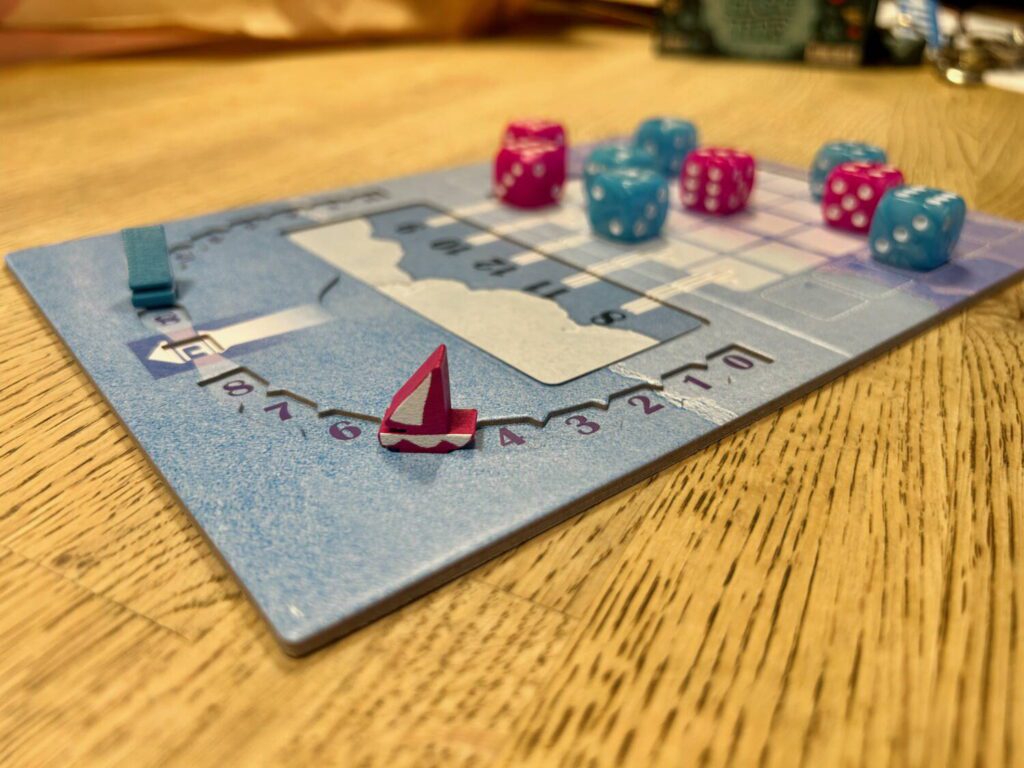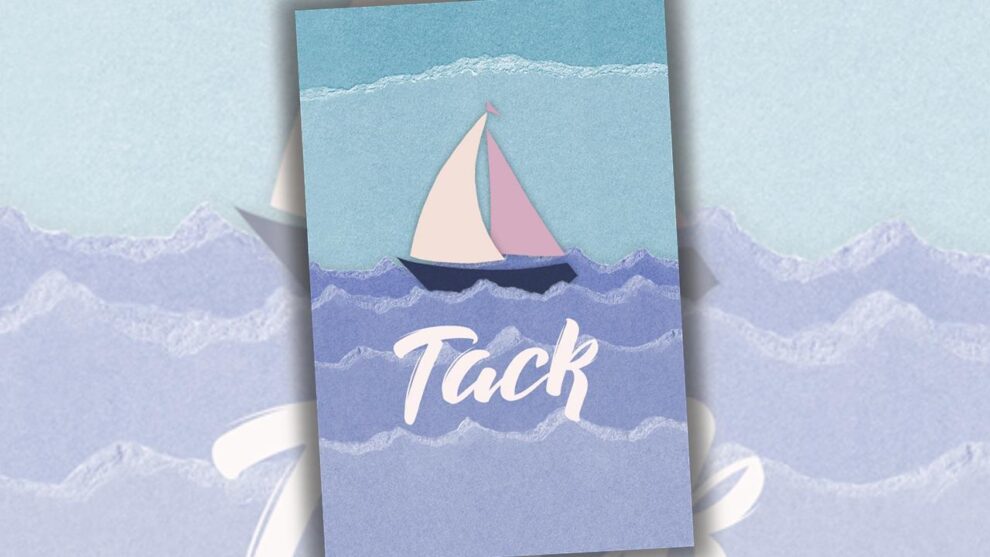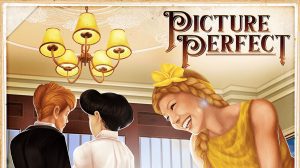Disclosure: Meeple Mountain received a free copy of this product in exchange for an honest, unbiased review. This review is not intended to be an endorsement.
Tack, designed by Amelie Le-Roche and published by Zerua Games, is a charming two-player game. I want to call it an abstract strategy game, but its use of dice might ruffle some feathers. I certainly wouldn’t call it a dice game, since that implies a certain kind of all-caution-to-the-wind adrenaline fest, and this is much more of a pensive, quiet experience. BoardGameGeek categorizes it as Area Movement, which is technically accurate but feels incorrect. Let’s leave that aside, since taxonomy is not our primary concern here. However you want to categorize it, Tack is good, and that’s what matters.
The main recess in the dual-layered board is divided into a five-by-five grid. Across the top, a randomly chosen Wind card assigns a value of between 7 and 13 to each column. Both players roll their dice, which are beautiful pastel blues and pinks, then place one die on their end of each row. You move one die every turn, either to the left or to the right but always within the same row. You can’t jump over your opponent’s dice, no matter how you may want to.
Any time all the dice in a given column add up to that column’s value on the Wind card, each player scores one point per die they have in that column. The score board, marked with two wooden boats, makes an arch above the player board, culminating in the beacon of a lighthouse. The first player to reach the beacon, which marks nine points, is the winner.
 Obstructionism is the name of the game. There are a lot of exchanges, a number of turns in the short play time that are spent in mutual acknowledgement that neither of you are going to get what you want. You don’t get to change the values of your dice for as long as they’re on the board. It is possible to position things at a near-total impasse, but you can resort to the nuclear option.
Obstructionism is the name of the game. There are a lot of exchanges, a number of turns in the short play time that are spent in mutual acknowledgement that neither of you are going to get what you want. You don’t get to change the values of your dice for as long as they’re on the board. It is possible to position things at a near-total impasse, but you can resort to the nuclear option.
If a column total ever exceeds the value on the Wind card, all implicated dice are removed, rerolled, and replaced in their starting positions. Completing or botching a column are the only two ways to change your dice. This is where Tack will lose the abstract strategy purists, the people who need to know everything. From time to time, luck plays a part. It’s worth noting, though, that in my experience, no die values seem superior to others. Large values allow you to swing control of sums, while small values give you permission to play my favorite role in board games, that of the mischievous imp. “Did you intend to add your four to that six to make ten? I’m so sorry. It needs a three now,” he chortled as he slid a one into the column.
 There are optional Storm cards that introduce abilities—change a die’s value, jump over a die, things like that—but the core of the game is always approachable and strangely serene, especially given how confrontational it is. Le-Roche designed the game during the COVID lockdowns to give her and her husband something quick to play, and that intimacy comes across. This is a quiet game for two people to hover over. It’s perfect for playing at a restaurant while you wait for your food, or on a park bench. The aesthetic choices, the construction paper art and color palette, add to Tack’s soothing qualities.
There are optional Storm cards that introduce abilities—change a die’s value, jump over a die, things like that—but the core of the game is always approachable and strangely serene, especially given how confrontational it is. Le-Roche designed the game during the COVID lockdowns to give her and her husband something quick to play, and that intimacy comes across. This is a quiet game for two people to hover over. It’s perfect for playing at a restaurant while you wait for your food, or on a park bench. The aesthetic choices, the construction paper art and color palette, add to Tack’s soothing qualities.
Tack is exactly the kind of game I mourn when I consider the impact of tariffs, for however long they or the fear of them will continue to haunt this hobby. The worst of those tariffs seem behind us now, but I played Tack during their frenzied peak, and so that is where my thoughts went. The Catans of this world will endure. We will always have a Ticket to Ride. In a world without free trade, a small publisher like Zerua and an unknown designer like Amelie Le-Rouche won’t have access to the level of production seen here. This is a beautiful product, made without much consideration of whether or not it will turn an enormous profit. Games with real capital behind them will continue, even if they’re a bit more expensive. Small print-run titles, the games where designers are often really trying something new or strange or something unconcerned with marketability, will either diminish significantly in quality and quantity, or simply disappear. That would be a real shame. The world is better for its Tacks.











